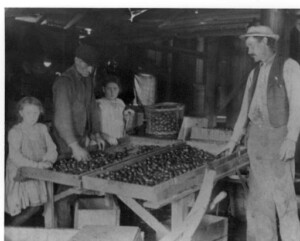Prunes
Prune orchards were first planted about 1890 in the hills south of Salem in the Liberty, Sunnyside and Rosedale areas. Many of these orchards were bought and developed by the Oregon Land Company before 1900. The trees were planted so that horses, and tractors (after about 1920) could be used to cultivate and plow between them. Efforts were made to mulch and hold in the moisture because there was no irrigation at the time.

Sorting prunes that have been washed in lye in a Scotts Mills drier are Steve Conner and Newt Commons, watched by Edna and Laura Commons., WHC Collections 2004.010.0365
The prunes were harvested in early September by migrating pickers who lived in one-room shacks that the orchardists built for them. After being gathered from the ground into buckets, the prunes were boxed up and taken to the dryers to be washed and stacked in trays for drying.
The prune drier closest to downtown Salem was located near South Commercial in the Candalaria area, where the Falk’s had a prune orchard. Another orchard and drier was near 12th and Sunnyside, near the Hilfiker’s orchard. Between 1905 and 1930, nearly seventy driers could be found within a radius of about 2 1/2 miles from Liberty and Reese Hill Road.
The driers were large barn-like structures with furnaces, frequently from the Rosebraugh Foundry in Salem, used to dry the fruit by heat. Many of the driers were near springs; otherwise a 30 to 50-foot-deep well had to be dug for water, and a windmill, gas engine or hand power used to pump it. Transportation only ran to Salem Heights at the time, and because the buildings beyond that were so “strung out,” it was called “String Town.”
Salem’s involvement with prunes was chiefly with Italian, or “purple plum,” prunes. In the depression of the 1930’s, canned prunes were the cheapest fruit one could buy, but in later years the market swung to pears and peaches, and fewer prunes were canned. After 1982, housing developments took over most of the land formerly used for prune orchards.
Written by Joan Marie “Toni” Meyering
Edited by Katherine Wallig
Bibliography:
Cammack, Forest. “Prune Industry West Coast, USA, 1890-1982.” Marion
County History, School Days II, Vol. 14 ( Marion County Historical Society, 1983), pp. 10-26.
This article originally appeared on the original Salem Online History site and has not been updated since 2006.







Leave A Comment